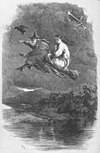The Samlesbury witches were three women from the Lancashire village of Samlesbury—Jane Southworth, Jennet Bierley, and Ellen Bierley—accused by a 14-year-old girl, Grace Sowerbutts, of practising witchcraft. Their trial at Lancaster Assizes in England on 19 August 1612 was one in a series of witch trials held over two days, among the most famous in English history. They were unusual for England at that time in two respects: Thomas Potts, the clerk to the court, published the proceedings in his The Wonderfull Discoverie of Witches in the Countie of Lancaster; the number of the accused found guilty and hanged was unusually high, ten at Lancaster and another at York. However, all three Samlesbury witches were acquitted. The charges against the women included child murder and cannibalism. In contrast, the others tried at the same assizes, who included the Pendle witches, were accused of maleficium—causing harm by witchcraft. The case against the three women collapsed "spectacularly" when Grace Sowerbutts was exposed by the trial judge to be "the perjuring tool of a Catholic priest". Many historians, notably Hugh Trevor-Roper, have suggested that the witch trials of the 16th and 17th century were a consequence of the religious struggles of the period, with both Catholic and Protestant Churches determined to stamp out what they regarded as heresy. (more...)
Recently featured: Alice in Chains – Natalie Clifford Barney – Atmosphere of Jupiter
